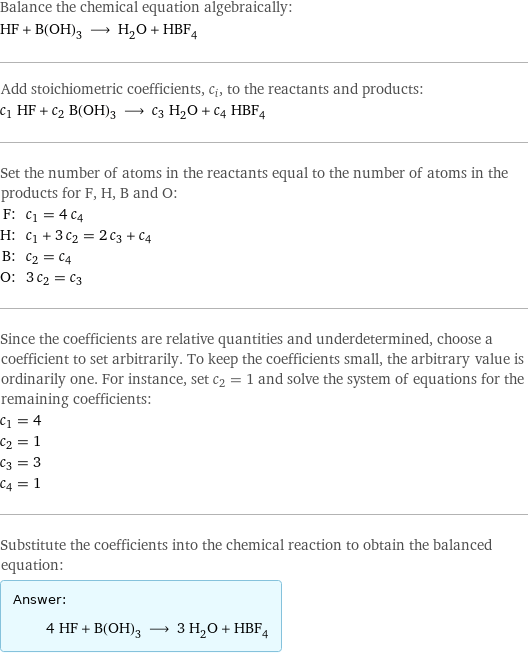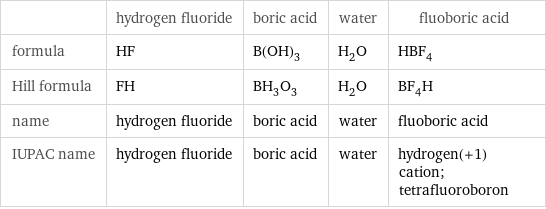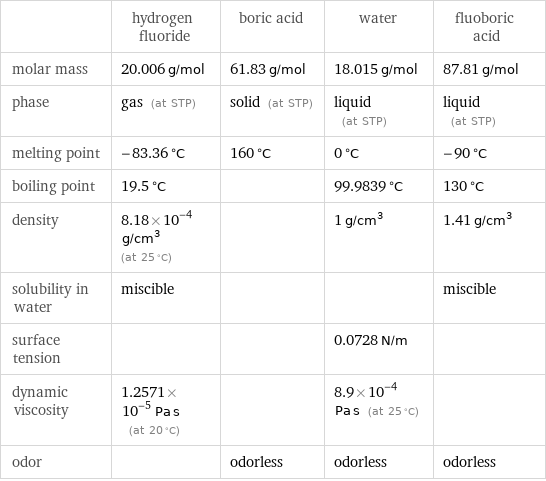Input interpretation

HF hydrogen fluoride + B(OH)_3 boric acid ⟶ H_2O water + HBF_4 fluoboric acid
Balanced equation

Balance the chemical equation algebraically: HF + B(OH)_3 ⟶ H_2O + HBF_4 Add stoichiometric coefficients, c_i, to the reactants and products: c_1 HF + c_2 B(OH)_3 ⟶ c_3 H_2O + c_4 HBF_4 Set the number of atoms in the reactants equal to the number of atoms in the products for F, H, B and O: F: | c_1 = 4 c_4 H: | c_1 + 3 c_2 = 2 c_3 + c_4 B: | c_2 = c_4 O: | 3 c_2 = c_3 Since the coefficients are relative quantities and underdetermined, choose a coefficient to set arbitrarily. To keep the coefficients small, the arbitrary value is ordinarily one. For instance, set c_2 = 1 and solve the system of equations for the remaining coefficients: c_1 = 4 c_2 = 1 c_3 = 3 c_4 = 1 Substitute the coefficients into the chemical reaction to obtain the balanced equation: Answer: | | 4 HF + B(OH)_3 ⟶ 3 H_2O + HBF_4
Structures

+ ⟶ +
Names

hydrogen fluoride + boric acid ⟶ water + fluoboric acid
Equilibrium constant
![Construct the equilibrium constant, K, expression for: HF + B(OH)_3 ⟶ H_2O + HBF_4 Plan: • Balance the chemical equation. • Determine the stoichiometric numbers. • Assemble the activity expression for each chemical species. • Use the activity expressions to build the equilibrium constant expression. Write the balanced chemical equation: 4 HF + B(OH)_3 ⟶ 3 H_2O + HBF_4 Assign stoichiometric numbers, ν_i, using the stoichiometric coefficients, c_i, from the balanced chemical equation in the following manner: ν_i = -c_i for reactants and ν_i = c_i for products: chemical species | c_i | ν_i HF | 4 | -4 B(OH)_3 | 1 | -1 H_2O | 3 | 3 HBF_4 | 1 | 1 Assemble the activity expressions accounting for the state of matter and ν_i: chemical species | c_i | ν_i | activity expression HF | 4 | -4 | ([HF])^(-4) B(OH)_3 | 1 | -1 | ([B(OH)3])^(-1) H_2O | 3 | 3 | ([H2O])^3 HBF_4 | 1 | 1 | [HBF4] The equilibrium constant symbol in the concentration basis is: K_c Mulitply the activity expressions to arrive at the K_c expression: Answer: | | K_c = ([HF])^(-4) ([B(OH)3])^(-1) ([H2O])^3 [HBF4] = (([H2O])^3 [HBF4])/(([HF])^4 [B(OH)3])](../image_source/2c7d3b2b68841c05f9ba4b6cbc261fb4.png)
Construct the equilibrium constant, K, expression for: HF + B(OH)_3 ⟶ H_2O + HBF_4 Plan: • Balance the chemical equation. • Determine the stoichiometric numbers. • Assemble the activity expression for each chemical species. • Use the activity expressions to build the equilibrium constant expression. Write the balanced chemical equation: 4 HF + B(OH)_3 ⟶ 3 H_2O + HBF_4 Assign stoichiometric numbers, ν_i, using the stoichiometric coefficients, c_i, from the balanced chemical equation in the following manner: ν_i = -c_i for reactants and ν_i = c_i for products: chemical species | c_i | ν_i HF | 4 | -4 B(OH)_3 | 1 | -1 H_2O | 3 | 3 HBF_4 | 1 | 1 Assemble the activity expressions accounting for the state of matter and ν_i: chemical species | c_i | ν_i | activity expression HF | 4 | -4 | ([HF])^(-4) B(OH)_3 | 1 | -1 | ([B(OH)3])^(-1) H_2O | 3 | 3 | ([H2O])^3 HBF_4 | 1 | 1 | [HBF4] The equilibrium constant symbol in the concentration basis is: K_c Mulitply the activity expressions to arrive at the K_c expression: Answer: | | K_c = ([HF])^(-4) ([B(OH)3])^(-1) ([H2O])^3 [HBF4] = (([H2O])^3 [HBF4])/(([HF])^4 [B(OH)3])
Rate of reaction
![Construct the rate of reaction expression for: HF + B(OH)_3 ⟶ H_2O + HBF_4 Plan: • Balance the chemical equation. • Determine the stoichiometric numbers. • Assemble the rate term for each chemical species. • Write the rate of reaction expression. Write the balanced chemical equation: 4 HF + B(OH)_3 ⟶ 3 H_2O + HBF_4 Assign stoichiometric numbers, ν_i, using the stoichiometric coefficients, c_i, from the balanced chemical equation in the following manner: ν_i = -c_i for reactants and ν_i = c_i for products: chemical species | c_i | ν_i HF | 4 | -4 B(OH)_3 | 1 | -1 H_2O | 3 | 3 HBF_4 | 1 | 1 The rate term for each chemical species, B_i, is 1/ν_i(Δ[B_i])/(Δt) where [B_i] is the amount concentration and t is time: chemical species | c_i | ν_i | rate term HF | 4 | -4 | -1/4 (Δ[HF])/(Δt) B(OH)_3 | 1 | -1 | -(Δ[B(OH)3])/(Δt) H_2O | 3 | 3 | 1/3 (Δ[H2O])/(Δt) HBF_4 | 1 | 1 | (Δ[HBF4])/(Δt) (for infinitesimal rate of change, replace Δ with d) Set the rate terms equal to each other to arrive at the rate expression: Answer: | | rate = -1/4 (Δ[HF])/(Δt) = -(Δ[B(OH)3])/(Δt) = 1/3 (Δ[H2O])/(Δt) = (Δ[HBF4])/(Δt) (assuming constant volume and no accumulation of intermediates or side products)](../image_source/1bc334fb3a49bfb94011bc3f2e5f7dc1.png)
Construct the rate of reaction expression for: HF + B(OH)_3 ⟶ H_2O + HBF_4 Plan: • Balance the chemical equation. • Determine the stoichiometric numbers. • Assemble the rate term for each chemical species. • Write the rate of reaction expression. Write the balanced chemical equation: 4 HF + B(OH)_3 ⟶ 3 H_2O + HBF_4 Assign stoichiometric numbers, ν_i, using the stoichiometric coefficients, c_i, from the balanced chemical equation in the following manner: ν_i = -c_i for reactants and ν_i = c_i for products: chemical species | c_i | ν_i HF | 4 | -4 B(OH)_3 | 1 | -1 H_2O | 3 | 3 HBF_4 | 1 | 1 The rate term for each chemical species, B_i, is 1/ν_i(Δ[B_i])/(Δt) where [B_i] is the amount concentration and t is time: chemical species | c_i | ν_i | rate term HF | 4 | -4 | -1/4 (Δ[HF])/(Δt) B(OH)_3 | 1 | -1 | -(Δ[B(OH)3])/(Δt) H_2O | 3 | 3 | 1/3 (Δ[H2O])/(Δt) HBF_4 | 1 | 1 | (Δ[HBF4])/(Δt) (for infinitesimal rate of change, replace Δ with d) Set the rate terms equal to each other to arrive at the rate expression: Answer: | | rate = -1/4 (Δ[HF])/(Δt) = -(Δ[B(OH)3])/(Δt) = 1/3 (Δ[H2O])/(Δt) = (Δ[HBF4])/(Δt) (assuming constant volume and no accumulation of intermediates or side products)
Chemical names and formulas

| hydrogen fluoride | boric acid | water | fluoboric acid formula | HF | B(OH)_3 | H_2O | HBF_4 Hill formula | FH | BH_3O_3 | H_2O | BF_4H name | hydrogen fluoride | boric acid | water | fluoboric acid IUPAC name | hydrogen fluoride | boric acid | water | hydrogen(+1) cation; tetrafluoroboron
Substance properties

| hydrogen fluoride | boric acid | water | fluoboric acid molar mass | 20.006 g/mol | 61.83 g/mol | 18.015 g/mol | 87.81 g/mol phase | gas (at STP) | solid (at STP) | liquid (at STP) | liquid (at STP) melting point | -83.36 °C | 160 °C | 0 °C | -90 °C boiling point | 19.5 °C | | 99.9839 °C | 130 °C density | 8.18×10^-4 g/cm^3 (at 25 °C) | | 1 g/cm^3 | 1.41 g/cm^3 solubility in water | miscible | | | miscible surface tension | | | 0.0728 N/m | dynamic viscosity | 1.2571×10^-5 Pa s (at 20 °C) | | 8.9×10^-4 Pa s (at 25 °C) | odor | | odorless | odorless | odorless
Units
